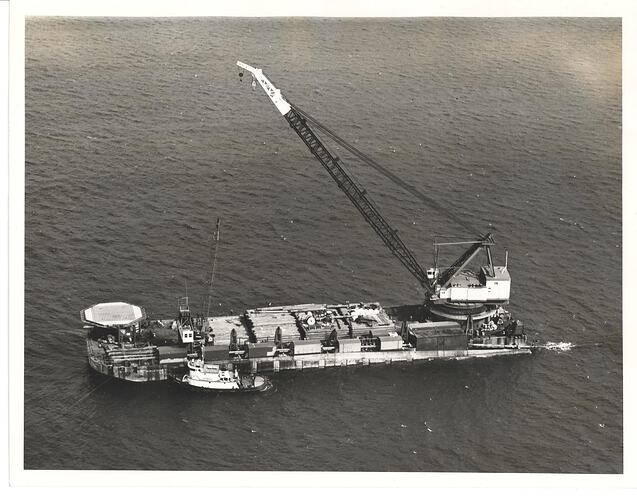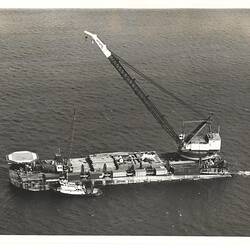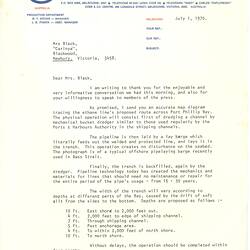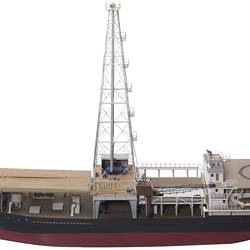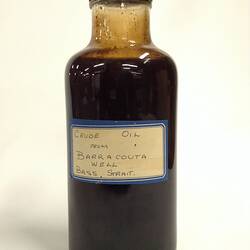Summary
Black and white image of the Ingram Derrick Barge No. 5 laying pipe in Bass Strait, circa 1970, providing a vital link between the island state of Tasmania with the mainland of Australia.
This image accompanied a letter from R.B. Cheetham, Public Affairs Department, Esso Standard Oil (Aust) Ltd, to Hope Black dated 1 July 1970. The letter was written in response to a conversation between Cheetham and Black and included a map outlining the proposed route of ethane pipeline across Port Phillip Bay, this photograph of a typical offshore pipe laying barge, and details of different trench depths across the bay.
Hope Macpherson was the first female curator at National Museum of Victoria (now Museum Victoria). Hope Macpherson along with Isobel Bennett, Susan Ingham and Mary Gillham were the first women to visit the Antarctic in their December 1959 expedition.
Description of Content
Black and white image showing full view of the barge including a crane on the right end, a helicopter pad on the left end with a tug boat moored to the side of the barge not far from the helicopter pad, in the open sea.
Physical Description
Black and white image.
Significance
The Hope (Macpherson) Black Collection is a significant addition to Museum Victoria's working lives collection, it reveals the journey of a woman from depression era Melbourne and illustrates the power of education. It also reveals the often discriminatory policies in place in Victoria before the equal opportunity developments of the late 20th century. In balance though it also exposes the somewhat free expression possible for empowered women in this period. Hope Macpherson clearly states that in her day to day work she never felt discrimination and believes she was given great opportunity to pursue her career and aspirations. However, on analysis her role was often shaped by her gender and its perceived strengths and weaknesses; she was dissuaded from applying to become a taxidermist as it was 'an unsuitable job for a woman', although part of the first group of female scientists allowed to travel to Macquarie Island they were not permitted to camp on land with the male crew for fear of inciting passions. And finally after a distinguished career she was forced to resign her tenure as Australia's first female Curator when she married late in life, as a consequence of the Marriage bar.
More Information
-
Collection Names
-
Collecting Areas
-
Acquisition Information
Donation from Hope Black (nee Macpherson), Apr 2011
-
Place & Date Depicted
-
Sender
Esso Australia Ltd, Melbourne, Victoria, Australia, 1 Jul 1970
Image was included in a letter from Esso is signed by R.B. Cheetham, Public Affairs Department -
Addressed To
Hope Black (nee Macpherson), Newbury, Victoria, Australia, 1 Jul 1970
Image was included in a letter from Esso addressed to Hope. -
Format
Photograph, Black & White
-
Inscriptions
The Ingram Derrick Barge No. 5 during pipe laying operations in Bass Strait (hand written in black pen). 1005/26 (hand written in pencil).
-
Classification
-
Category
-
Discipline
-
Type of item
-
Image Dimensions - Photograph
215 mm (Width), 167 mm (Height)
-
Keywords
